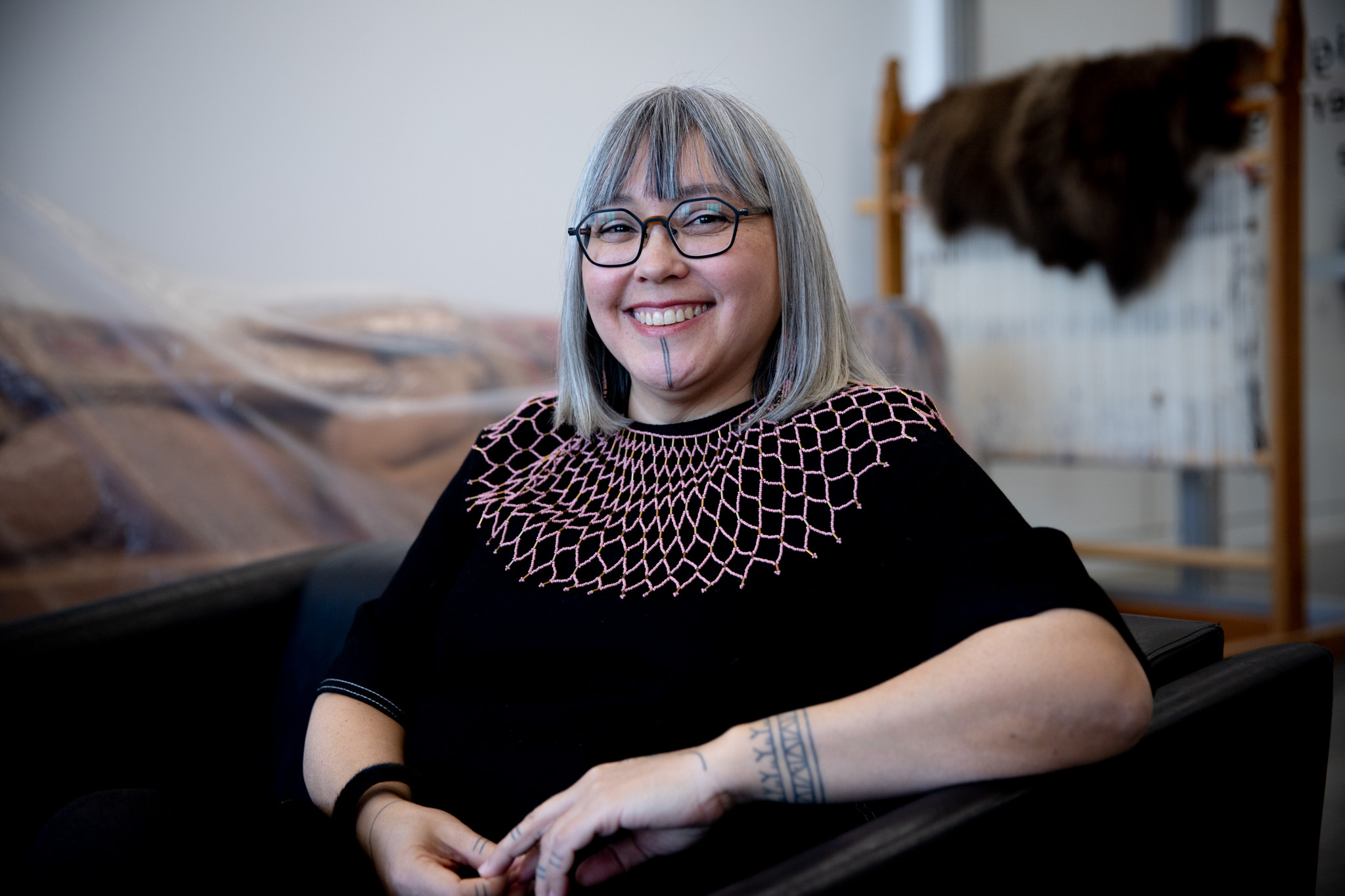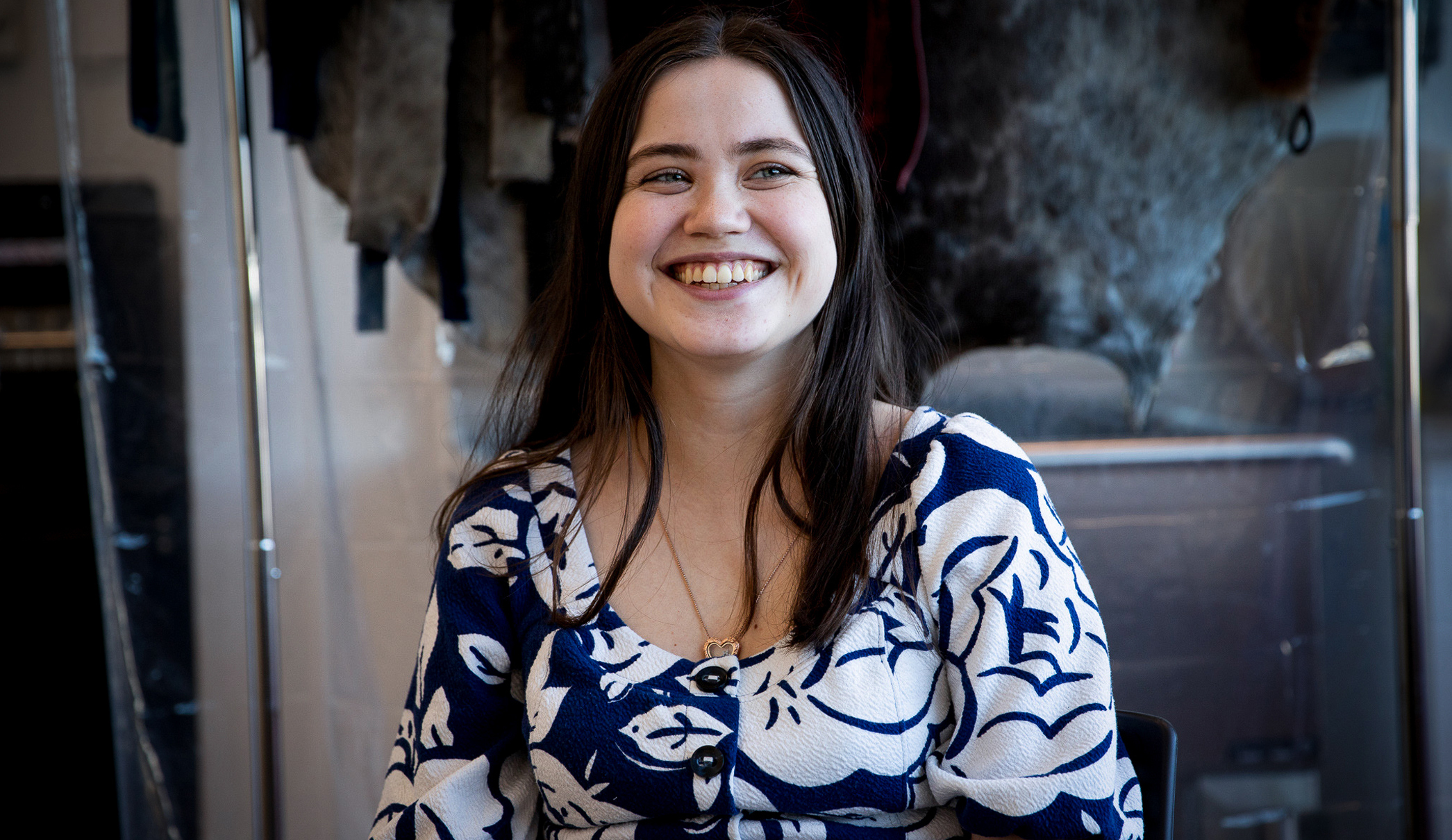Kajola Morewood Fosters Community Connections as AGP’s Newest Manager

“I’m looking forward to getting to know the students a little bit more and learning what else we can do to support them,” Kajola Morewood, manager of Aboriginal Programs at ECU, says. (Photo by Perrin Grauer)
Posted on | Updated
The artist, educator and information services specialist aims to engage with the full spectrum of how Indigenous identities and creative practices are formed.
For years before landing a job as manager at the Aboriginal Gathering Place (AGP) this past November, Kajola Morewood (BFA 2011) had wanted to work there.
The artist, educator and ECU alum worked in several departments at Emily Carr over 25 years. More recently, she worked as Indigenous initiatives and services librarian at Okanagan College. But she always remembered her first interactions with Brenda Crabtree, director of Aboriginal Programs at ECU and Special Advisor to the President on Indigenous Initiatives.
“She was so welcoming,” Kajola tells me. “She was always saying, come into this space, learn more about your culture. Because I didn’t really have a lot of that. So, I feel like she kind of changed my life.”
Kajola, whose birth mother is Inuit, grew up in a settler family between Southern Alberta and BC. She had little understanding of Inuit culture as a child. What little she knew, she learned through videos, books or presentations in school.
Brenda encouraged Kajola to foster her curiosity about her culture. In Kajola’s early days as a staff member in Student Services, Brenda helped her secure time off for a trip along the coast of Baffin Island. For the first time, Kajola saw landscapes like her mother might have known growing up in Kuujjuarapik. She also met some of the people who lived there.
In one community, Kajola visited a school gym where students were hip-hop dancing and eating country food. One of the students approached her and said he and his classmates thought she looked Inuit.
“I said, yeah, I am. He said, where do you live? I said Vancouver, and he was like, what are you doing there?” Kajola recalls.
“It was pretty cool to be recognized in that way. Because that doesn’t happen so much here. So, having the opportunity to make that trip was pretty incredible.”
This experience was an early introduction to the power of reconnecting with community.

An Inuit beaded necklace made by Kajola on display at the Aboriginal Gathering Place. (Photo by Perrin Grauer)
The aspiration to share this experience with others has defined Kajola’s work. And it has deepened her exploration of the many ways Indigenous people encounter — and bridge — versions of the cultural disconnection she experienced.
While working toward her master’s degree in library and information studies, Kajola was part of a First Nations curriculum concentration. That meant she could focus on Indigenous perspectives and issues throughout her degree.
She studied the many problematic ways western institutions archive and catalogue Indigenous knowledge and belongings. She also studied “anthropological refusal” — a term for when research subjects refuse to engage with researchers or provide misinformation. This is often done because researchers have not earned the right to cultural knowledge. These issues can create enormous obstacles for Indigenous people trying to reconnect with cultures from which they’ve become estranged.
“What I’m looking at currently is a disruption of knowledge from community,” Kajola says. “And I’m thinking about how people are trying to mend those connections between the community and their histories. Because I didn’t grow up in an Inuit community. I didn’t have access to those teachings. I had to learn through books.”
These concerns also animate Kajola’s art practice. For an artist’s book, she collected pictures of herself as a child. She layered those images with materials like rabbit and seal fur, as well as stuffed dolls she created. Then she cross-stitched phrases she recalled from her childhood — fragments she’d picked up describing what it meant to be Inuit. Phrases like “Inuit have a hundred words for snow,” and “Inuit never get cold.”
“Which is obviously not true, but it was something I remember saying to somebody,” Kajola tells me. “It’s those things that I heard or thought about myself.”
In exploring the distance between her personal then-and-now, Kajola engages with the broader complexities of how an Inuit identity can develop.

An artwork by Kajola features pins stuck into rabbit fur. The fur is a nod to a precious possession from Kajola’s childhood. The pins reference stories of children who had pins stuck in their tongues in residential schools for speaking their language. The word “Inuujunga” means “‘I am Inuit,’ but can also be translated as ‘I’m a person,’” Kajola tells me. (Photo by Perrin Grauer)
At the AGP, she’s currently working with artist and Aboriginal program coordinator Sydney Frances Pascal on a speaker series. The series recently featured artist and ECU alum Maria-Margaretta (BFA 2018). Tricia Logan, academic director at the UBC Indian Residential School History and Dialogue Centre, will speak in the coming weeks.
Kajola is also working on instructions for making Inuit beaded necklaces — an example of which is now part of the AGP’s growing material-practice display. She aims to lead an AGP workshop to teach others to do the same.
“I’m looking forward to getting to know the students a little bit more and getting to know what their practices are about,” she says. “Learning what else we can do to support them.”
Stepping into this role more fully is partly an echo of the support she received from Brenda all those years ago.
“If I could do that for somebody else,” she adds, “that would be amazing.”
Visit the AGP’s website and follow them on Instagram to learn more about their extraordinary range of programming.



